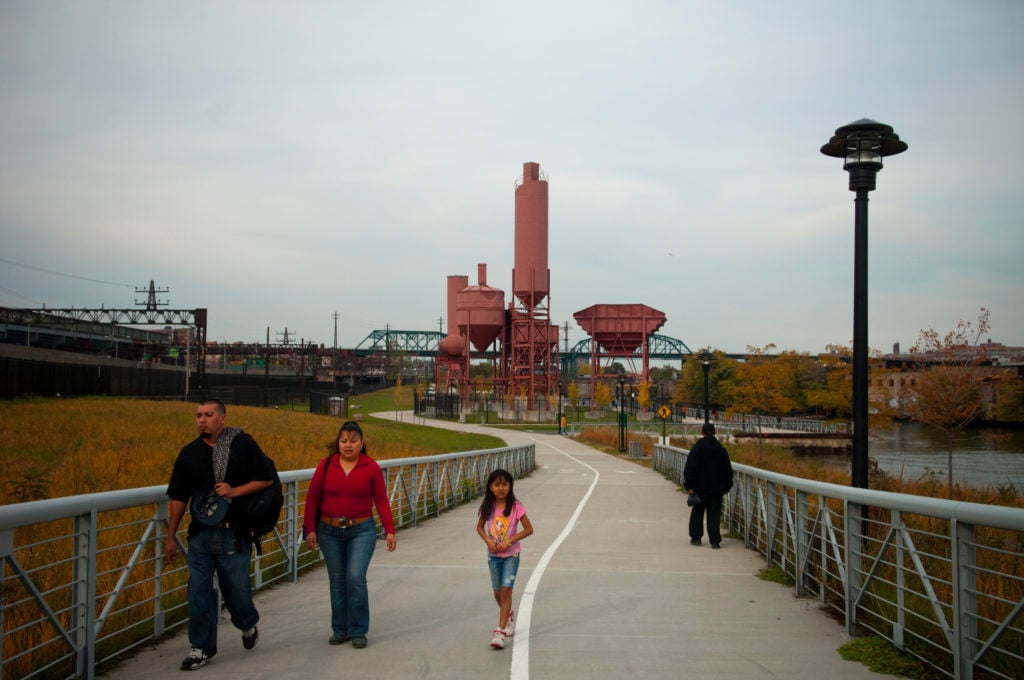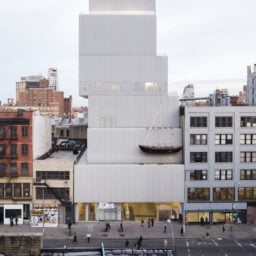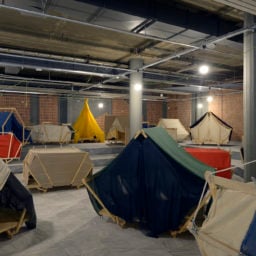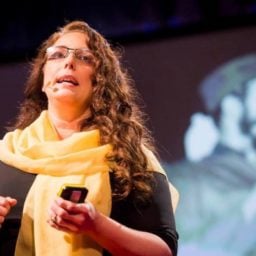“They had a warning at least,” said Tiara Torres, co-director of the grassroots, Bronx-based arts collective Hydro Punk, days after the New Museum’s symposium IdeasCity The Bronx abruptly shut down, just minutes after getting started.
In July, Torres had run into the New Museum staffer who had emailed Hydro Punk about participating in the event, held in Concrete Park, a public space newly rebuilt by local organizers in a part of the South Bronx undergoing contentious rezoning. The collective never responded to the email, but Torres explained in person that Hydro Punk would not be participating—they were uncomfortable giving the New Museum “our voices,” especially for an event held on home soil.
But Torres said she would attend as a community member. She arrived at Concrete Park in the early afternoon of Saturday, September 21, with a prepared statement. Other activists came too. “I didn’t know that it was going to be such an action,” she said.
The Idea Behind IdeasCity
The New Museum’s IdeasCity initiative began in 2011. Early press releases explained that the initiative took as its “core belief that arts and culture constitute a driving force behind the vitality of urban centers worldwide.” The museum has since organized initiatives in national and international cities, its native New York included. Each iteration begins with a week-long residency and culminates in a symposium.
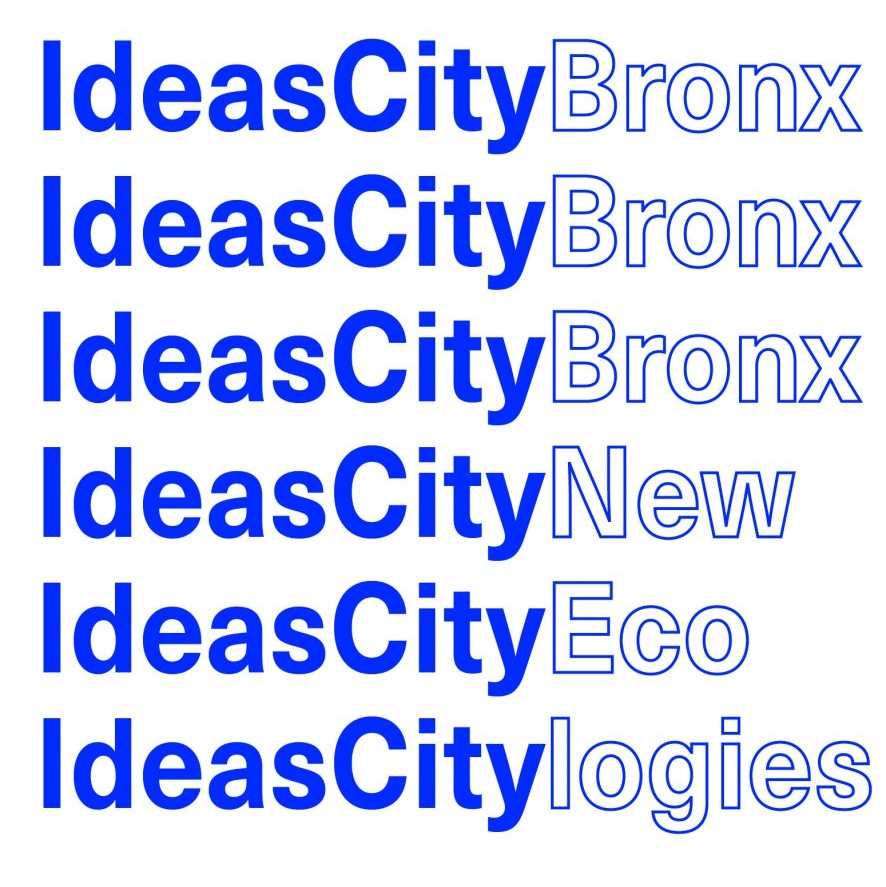
A graphic for IdeasCity Bronx.
Attempts have been made over the years to anticipate the suspicion residents of rapidly changing cities might feel toward a Manhattan institution coming in to talk about their home. Before IdeasCity Detroit in 2015, for instance, the New Museum released a “Memorandum of Understanding” that promised to “honor and value the people of Detroit by retaining and utilizing both human and material resources that reflect the demographics” of the city.
Yet no such memorandum accompanied the announcement that IdeasCity would come to the Bronx, a place much closer to home, for an event themed “New Ecologies 3755”—the number a reference to the days left before 2030, when experts believe global warming may reach critical levels. “The conversations about climate justice and the arts and culture that have already been happening [in the Bronx] without [the New Museum],” said Torres, pointing to one of the key concerns over outside institutions coming into gentrifying or long-marginalized neighborhoods: that they will claim the work of grassroots organizers as their own, thus erasing the labor of black and brown people.
The New Museum is not the first to face opposition from communities in rapidly changing neighborhoods. In the Bronx, an urban blight-themed party sponsored by artist Lucien Smith titled the “Macabre Suite,” featuring trash fires and bullet ridden cars, touched off huge public anger in 2015, while activists in the Bronx shut down the “It’s the Bronx” music festival in March of this year.
As wealth disparities in major cities grow and the art world becomes more critical of its own classism and lack of diversity, the debate over whether cultural institutions can responsibly enter embattled neighborhoods has become all the more heated.
Building Tensions
The week before IdeasCity The Bronx, curator V. Mitch McEwen, an architect and urban planner who teaches at Princeton, told the New York Times the goal was to “think through new ecologies” while “combining art and activism.” This latter aim was achieved with perhaps more efficacy than anyone had imagined.
Concerned buzz around IdeasCity The Bronx began late in the summer, after the real estate company South Bronx Luxury began promoting IdeasCity on Instagram. (The New Museum has “no connection or communication” with the company, said a spokesperson.) New developments pegged as “luxury” typically accelerate steeper costs of living in gentrifying neighborhoods—and, according to census data, median rents already grew 45 percent in the Bronx over the past decade—so South Bronx Luxury’s interest raised flags for activists.
https://www.instagram.com/p/B2l1Zk5A00P/
Then, the September 18 New York Times feature on IdeasCity celebrated river-adjacent Concrete Plant Park as having “significance as a locale for an event that deals with systemic inequities, climate change, urban space and water.” The article, which gave little context on the park’s history, prompted The Point CDC, an organization instrumental in transforming the park, to issue a public statement on social media. The Point asserted that any event on environmental justice in the Bronx should have involved preliminary planning meetings with grassroots groups and claimed that only one of the organizations in their environmental justice network had been contacted about participating. (A New Museum spokesperson said that the museum had reached out to The Point CDC about participating in a plenary session for IdeasCity in June, but had not received a response.)
Artist and activist Shellyne Rodriguez had initially agreed to appear on a panel at IdeasCity (and participated in the IdeasCity podcast). “I was sort of asleep at the wheel about this,” she acknowledged, explaining that there were “two strains” of resistance that mounted in the days leading up to the event.
On the one hand, there was the conversation Hydro Punk ignited about whether the New Museum should come to the Bronx at all. On the other, there was the conversation about the crediting and full inclusion of Bronx-based cultural organizations.
A Meltdown
By Friday, September 20, participants began to pull out. DreamYard Art Center said they would no longer participate in “what has turned out not to be a collaboration, but something in which DreamYard’s name has seemingly been used as merely a means to an end.” Artist Xaviera Simmons, who organized a panel on deconstructing “what whiteness actually is,” said “it would be both insensitive and counterproductive to host and be a party to a panel on white privilege” under “the current circumstances.”
The afternoon of the event, as McEwen worked her way through introductory remarks, Torres initiated a mic check, projecting her voice loud so that the other activists in attendance could repeat and amplify her words. But McEwen quickly offered her the actual microphone and Torres went to speak on stage. “New Museum has never invested anything in the Bronx,” she said. “Their name erases the work of black and brown people who have died on this land.”
She continued uninterrupted until a museum staffer asked her not to swear—which felt, Torres recalled, “kind of like telling me to tone police myself.”
When she finished speaking, she moved to hand the mic to Shellyne Rodriguez. According to Torres and Rodriguez, New Museum staff protested, though the museum’s spokesperson says that McEwan handed over both the mic and stage to the activists. Either way, Rodriguez continued sans mic, projecting her voice as others spoke over her, and NYPD officers who had been stationed near the periphery of the park moved closer. Minutes later, McEwen announced that the event was over.
In the statement the New Museum sent to Artnet News and other organizations who asked for comment, the institution reiterated that “we wholeheartedly support V. Mitch McEwen’s curatorial vision for IdeasCity” and claimed that recent Ideas City programs had “advanced thinking in significant directions.”
A two-page statement McEwen posted to Twitter on Sunday, September 22, attempted to provide context on the now-canceled event: “When New Museum invited me to curate the 2019 cycle of IdeasCity, I knew that this would be the first instance of Black leadership in that program, since its founding in 2011. I decided that I would only take on the yearlong role if New Museum proved open to using the IdeasCity platform to pair the typical focus on the future of cities with a year-long focus on dismantling white supremacy and centering Black and brown ideas of transformation.”
While The Point CDC had criticized the “top-down” planning process for not adequately deferring to local expertise, McEwen said that the event was “not about the Bronx or for the Bronx. These were panels and events, organized mostly by Bronx grassroots leaders, that one expected to be thoughts on the planetary.” She went on to explain what she had hoped would come of the event:
I was hoping to invite the IdeasCity audience—as arbitrary, art geeky, and policy wonky as that audience may be—to hear directly from those doing the day-to-day work of making another world possible. As far as I can tell, in New York City today, those leaders are mostly in the Bronx.
However, savior narratives are so prolific, so dominant, that this paradigm was easily garbled in every retelling.
McEwen ended with questions, including: “For those few organizations and people who bravely organize and support themselves without being compromised—how do we contact and learn from your vast and deep intelligence without being extractive?” The terms “few” and “support themselves” framed remaining un-compromised as both a rarity and economically precarious.
Push Back
Torres, whose collective Hydro Punk has been hosting art events that champion local artists and musicians as well as offering political education workshops since 2014, is not sure there is a non-extractive way to enter the Bronx. She added that, given that the newly unionized New Museum staff were threatening to strike if their protracted contract fight remained unresolved, even if the event had been held at the museum, attending could have required Bronx organizers to cross a picket line.
“As much as they want to help and be saviors, it’s not responsible,” Torres said. “The more I think about it, it just felt like we were in a test tube.”
Rodriguez, who has been involved with Take Back the Bronx since its 2011 founding, agreed: “There is no responsible way, given the context that we are in, for New Museum to come to the Bronx to do anything right now.”
Beyond new development and rising rents, what is happening right now in the Bronx includes the Southern Boulevard rezoning project. The proposed rezoning could allow residential development in areas that are now primarily occupied light industrial businesses. The city claims that the goal is to increase affordable housing and economic development, but the real estate website The Real Deal already predicts that rezoning will bring a “development boom.” Residents worry that, without proper protections, the net effect of rezoning will be displacement.
Cultural events hosted by outside organizations can put community members in the difficult position of having to choose between principles and participation. “People on the outside have to realize that when they come in, they’re actually creating a wedge in the community that’s already facing a lot of challenges,” said Gregory Jost, a Bronx-based researcher and organizer who works at the Banana Kelly Community Improvement Association. “It turns into a divide and conquer mechanism, just like the rezoning [itself] would be. Do you want to be at the table and negotiate and see what you can get, or are you so opposed to the entire process that you just say ‘no, I don’t want to participate at all’?”
Jost, who has written compellingly about how national grassroots organizations fought redlining by acquiring the bank data that showed structural racism, believes that adequate data can “unify a vision” for activists. He also belongs to the group Designing the We, and contributed to their traveling exhibition, “Undesign the Redline,” which presented information on how racism became structural while inviting viewers to give their input on how the exhibition could better reflect their local experiences, reshaping depending on what city it was in. The exhibition aimed to acknowledge how profoundly local displacement was, while connecting different communities affected by similar forces.
Still, tensions over whether and how to participate have been sharp. When Take Back the Bronx disrupted and shut down a Department of City Planning workshop in June, City Limits reported that certain local attendees were frustrated with the group’s hard line. “I agree with them,” one retired teacher in attendance said. “However, they want everything to stay the same and I am not happy with that. If we participate we can be part of the change. And if the changes happen without us, we cannot complain.”
“We are having a seat at the table of our own displacement,” Shellyne Rodriguez fired back to City Limits.
A Shift in Perspective
The Detroit-based artist, musician, and activist Bryce Detroit applied to IdeasCity New Orleans, held this past April, because he wanted to better understand the affinity he felt for NOLA and its African diasporic identity, even though he had never spent time in the city. During the five-day residency, he indeed experienced a culture that resonated with African legacies in certain Detriot communities, but he said he also felt pressured by IdeasCity’s organizers to come up with environmental justice suggestions for New Orleans.
“At the most, we can share what’s going on in our respective hyper-local scenarios,” said Detroit. “It’s super problematic to enter a city and then ask artists who are not native to that place to do a quick analysis of the place and then come up with suggestions-slash-solutions for that place.”
He believes established art institutions can potentially enter communities like the Bronx respectfully—at least “in the land of hypotheticals,” he observed. “Yet it takes such intentionality. You gotta have a curator whose practice is actually rooted in grassroots social justice. It must be. You can’t be a person who is skilled at being adjacent to these issues, but in real life has no connection to the people on the front lines.”
The planning process, Detroit says, has to start with grassroots social justice and cultural leaders. “The institution inviting those people has to make it very clear: We’re actually looking at you as the responsible party to tell us not only how to enter, but what is the way that we can actually be a benefit to the place that we’re going to be.” The “folks on the ground,” he said, must also be the ones “responsible for creating the way that the narrative rolls out.”
To do this, museums would have to change their own staffing structures and begin to dismantle their own internal hierarchies. “But that is a major culture shift for institutions,” Detroit concluded.
